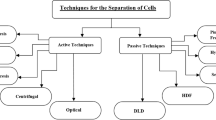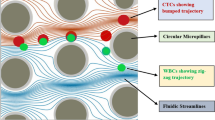Abstract
Circulating tumor cells (CTCs) are the cells, found in extremely few numbers in human blood branching out from the primitive tumor location, carried further by the circulation of blood passage, thus recognized as a major crucial bio-indicator for early and promising cancer cure and diagnosis. Deterministic lateral displacement (DLD), being a tried and tested passive technique depending on uneven bifurcation of laminar flow traversing through a structured array of microposts, is a promising method in isolating cells of differing sizes. In this study, a microfluidic device with a single sample inlet, two symmetrical buffer inlets and housing an asymmetric DLD array, has been presented that clearly distinguishes two distinctive CTCs from White blood cells (WBCs) using continuous flow through a single DLD array. Making use of a computation software COMSOL Multiphysics 5.4, simulated design of the proposed microfluidic device has been analyzed taking into account an infused blood sample comprising of massive CTCs branching from lung cancer site, CTCs branching from prostate cancer site and comparatively smaller WBCs of diametric sizes 22.5 µm, 10.64 µm and 12 µm correspondingly. The obtained response after simulation study shows that the proposed device design separates out two distinct CTCs from WBCs through corresponding specified outlets at elevated sample inflow rate of 22 × 10–6 kg/s and Re of 22.47 thus functioning appreciably at elevated value of throughput. The horizontal and vertical gaps between microposts have been optimized such that the DLD based device imposes minimal resistive imposition to the movement of cells, maintains unaltered pressure points distribution surrounding microposts and at outlets, amplifies throughput and provides superlative isolation efficiency and purity of extracted CTCs and WBCs.














Similar content being viewed by others
Data availability
All necessay data have already been provided in the paper itself. No extra data or dataset have been used in this work.
References
Aghilinejad A, Aghaamoo M, Chen X (2019) On the transport of particles/cells in high-throughput deterministic lateral displacement devices: Implications for circulating tumor cell separation. Biomicrofluidics 13:034112
Allard WJ et al (2004) Tumor cells circulate in the peripheral blood of all major carcinomas but not in healthy subjects or patients with nonmalignant diseases. Clin Cancer Res 10(20):6897–6904
Amasia M, Madou M (2010) Large-volume centrifugal microfluidic device for blood plasma separation. Bioanalysis 2:1701–1710
Bouche O, Beretta GD, Alfonso PG, Geissler M (2010) The role of anti-epidermal growth factor receptor monoclonal antibody monotherapy in the treatment of metastatic colorectal cancer. Cancer Treat Rev 36(Suppl 1):S1–S10
den Toonder J (2011) Circulating tumor cells: the grand challenge. Lab Chip 11:375–377
Dharmasiri U, Njoroge SK, Witek MA, Adebiyi MG, Kamande JW, Hupert ML, Barany F, Soper SA (2011) High-throughput selection, enumeration, electrokinetic manipulation, and molecular profiling of low-abundance circulating tumor cells using a microfluidic system. Anal Chem 83(6):2301–2309
Dong Y, Skelley AM, Merdek KD, Sprott KM, Jiang C, Pierceall WE, Lin J, Stocum M, Carney WP, Smirnov DA (2013) Microfluidics and circulating tumor cells. J Mol Diagn 15(2):149–157
Fachin F, Spuhler P, Martel-Foley JM et al (2017) Monolithic chip for high-throughput blood cell depletion to sort rare circulating tumor cells. Sci Rep 7:10936
González-Esparza D, Del Angel-Arroyo JA, Elvira-Hernández EA, Herrera-May AL, Aguilera-Cortés LA (2019) Design and modeling of a microfluidic device with potential application for isolation of circulating tumor cells. In: 2019 IEEE international conference on engineering Veracruz (ICEV), Boca del Rio, Veracruz, Mexico, pp 1–7
Haeberle S, Brenner T, Zengerle R, Ducrée J (2006) Centrifugal extraction of plasma from whole blood on a rotating disk. Lab Chip 6:776–781
Ishikawa T, Fujiwara H, Matsuki N, Yoshimoto T, Imai Y, Ueno H, Yamaguchi T (2011) Asymmetry of blood flow and cancer cell adhesion in a microchannel with symmetric bifurcation and confluence. Biomed Microdevices 13:159–167
Jin C et al (2014) Technologies for label-free separation of circulating tumor cells: from historical foundations to recent developments. Lab Chip 14(1):32–44
Johnson ES, Anand RK, Chiu DT (2015) Improved detection by ensemble-decision aliquot ranking of circulating tumor cells with low numbers of a targeted surface antigen. Anal Chem 87(18):9389–9395
Karimi A, Yazdi S, Ardekani AM (2013) Hydrodynamic mechanisms of cell and particle trapping in microfluidics. Biomicrofluidics 7:21501
Kersaudy-Kerhoas M, Sollier E (2013) Micro-scale blood plasma separation: from acoustophoresis to egg-beaters. Lab Chip 13:3323–3346
Kim J-H, Woenker T, Adamec J, Regnier FE (2013) Simple, miniaturized blood plasma extraction method. Anal Chem 85:11501–11508
Kim S-C et al (2017) Broken flow symmetry explains the dynamics of small particles in deterministic lateral displacement arrays. Proc Natl Acad Sci USA 114(26):E5034–E5041
Kottmeier J, Weber MW, Blahout S, Hussong J, Kampen I, Kwade A, Dietzel A (2019) Accelerated particle separation in a DLD device at Re > 1 investigated by means of µPIV. Micromachines 10:768
Kumar V, Rezai P (2017) Magneto-hydrodynamic fractionation (MHF) for continuous and sheathless sorting of high-concentration paramagnetic microparticles. Biomed Microdevices 19:39
Liu Z, Chen R, Li Y, Liu J, Wang P, Xia X, Qin L (2018) Integrated microfluidic chip for efficient isolation and deformability analysis of circulating tumor cells. Adv Biosyst 2(10):1800200
Meng S et al (2004) Circulating tumor cells in patients with breast cancer dormancy. Clin Cancer Res 10(24):8152–8162
Miller MC, Doyle GV, Terstappen LW (2010) Significance of circulating tumor cells detected by the cell search system in patients with metastatic breast colorectal and prostate cancer. J Oncol 2010:617421
Park S et al (2014) Morphological differences between circulating tumor cells from prostate cancer patients and cultured prostate cancer cells. PLoS One 9(1):e85264
Phillips KG et al (2012) Optical quantification of cellular mass, volume, and density of circulating tumor cells identified in an ovarian cancer patient. Front Oncol. https://doi.org/10.3389/fonc.2012.00072
Pødenphant M, Ashley N, Koprowska K, Mir KU, Zalkovskij M, Bilenberg B, Bodmer W, Kristensen A, Marie R (2015) Separation of cancer cells from white blood cells by pinched flow fractionation. Lab Chip 15(24):4598–4606
Qin L et al (2019) Highly efficient isolation of circulating tumor cells using a simple wedge-shaped microfluidic device. IEEE Trans Biomed Eng 66(6):1536–1541
Salafi T, Zhang Y, Zhang Y (2019) A review on deterministic lateral displacement for particle separation and detection. Nano Micro Lett 11:77
Songjaroen T, Dungchai W, Chailapakul O, Henry CS, Laiwattanapaisal W (2012) Blood separation on microfluidic paper-based analytical devices. Lab Chip 12:3392–3398
Witek MA, Freed IM, Soper SA (2019) Cell separations and sorting. Anal Chem 92(1):105–131
Yoon Y, Lee J, Ra M, Gwon H, Lee S, Kim MY, Yoo K-C, Sul O, Kim CG, Kim W-Y, Park J-G, Lee S-J, Lee YY, Choi HS, Lee S-B (2019) Continuous separation of circulating tumor cells from whole blood using a slanted weir microfluidic device. Cancers 11(2):200
Zeming K, Salafi T, Chen C et al (2016) Asymmetrical deterministic lateral displacement gaps for dual functions of enhanced separation and throughput of red blood cells. Sci Rep 6:22934
Zhang J, Yan S, Yuan D, Alici G, Nguyen NT, Warkiani ME, Li W (2016) Fundamentals and applications of inertial microfluidics: a review. Lab Chip 16:10–34
Zhou J, Kulasinghe A, Bogseth A et al (2019) Isolation of circulating tumor cells in non-small-cell-lung-cancer patients using a multi-flow microfluidic channel. Microsyst Nanoeng. https://doi.org/10.1038/s41378-019-0045-6
Author information
Authors and Affiliations
Corresponding author
Additional information
Publisher's Note
Springer Nature remains neutral with regard to jurisdictional claims in published maps and institutional affiliations.
Rights and permissions
Springer Nature or its licensor (e.g. a society or other partner) holds exclusive rights to this article under a publishing agreement with the author(s) or other rightsholder(s); author self-archiving of the accepted manuscript version of this article is solely governed by the terms of such publishing agreement and applicable law.
About this article
Cite this article
Bhattacharjee, R., Kumar, R. Computational evaluation of a microfluidic device for sorting multiple distinctive circulating tumor cells using single disproportionate deterministic lateral displacement array. Microsyst Technol 30, 127–139 (2024). https://doi.org/10.1007/s00542-023-05582-y
Received:
Accepted:
Published:
Issue Date:
DOI: https://doi.org/10.1007/s00542-023-05582-y




